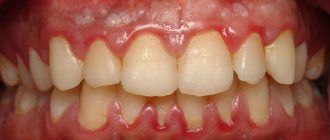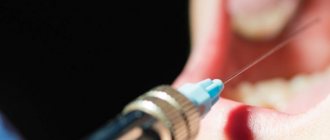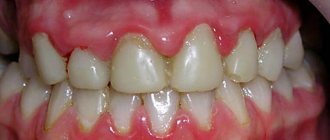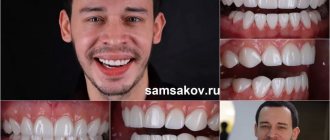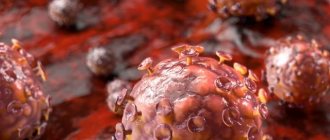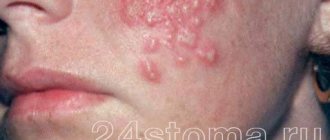Kuznetsova Ekaterina Valerievna
Pediatric dentist. Member of the international association of dentists IAPD. Best pediatric dentist 2022 on the DENTAL START forum.
Introduction
Stomatitis in children is an inflammatory disease of the oral mucosa. Lesions may be located on:
- language,
- cheeks,
- inner surface of the lip.
- gums
This process is associated with the body's immune response to a particular irritant or infectious agent. Stomatitis most often appears in children under 3 years of age, since the mucous membrane is still thin and reacts more actively than in adults.
The most common types of stomatitis:
- viral,
- candida,
- aphthous,
- traumatic.
For correct diagnosis and treatment, consultation with a pediatric dentist and pediatrician is required.
Herpetic stomatitis
The most common type of stomatitis. Most often, children aged 1 to 3 years are affected; it can also occur at an older age, but less frequently. Transmission occurs most often by airborne droplets; the child is contagious during the acute period. The child’s body encounters the virus and becomes a carrier in the future.
There are two types:
- acute primary,
- secondary recurrent.
First symptoms
Heat
The first symptoms of this disease are high temperature (38-39 degrees), which may be slightly less or more depending on the severity of the disease.
The temperature appears against the background of the child’s general health. After approximately 3-4 days, rashes appear on the mucous membrane of the oral cavity. On the lips, on the inner surface of the cheeks, tongue, palate, throat, around the mouth and sometimes on the phalanges of the thumbs. The number of rashes can be from 3 to 10-15 pieces. And just during this period there is a sharp decrease in body temperature to 37.5°C. This is a transition to the second stage of the disease. And continues to last up to 7 days depending on the progression of the infection.
This disease is sometimes confused with a sore throat, since the pharynx of the throat can be hyperemic (red). Very often, when such an error occurs, the child is prescribed antibacterial drugs, which do not help. And parents in despair cannot understand what to do.
Bubbles
The first phase of the rash is blisters that quickly burst. And then it looks like round-oval ulcers. Which cause pain when eating.
Smell from the mouth
Another symptom is putrid breath, as a specific symptom, and active salivation. This symptom differs from the active secretion of saliva during teething; the secretion of saliva is very active. The child refuses to eat and drink. All this is accompanied by swelling of the gums, redness, and bleeding. All these symptoms cause a lot of anxiety for both mother and child. It is better, of course, to seek help from a pediatric dentist, since this area of treatment is specifically dental.
The pediatric dentist will be able to make the correct diagnosis and adjust the treatment. Consultation with a pediatrician is also necessary, even if there are no signs of acute respiratory viral infection or flu.
Treatment
What treatment is usually necessary for viral herpetic stomatitis?
Gentle diet
The diet during illness consists of the warmest and softest food possible. It is necessary to exclude the consumption of sour, salty, hot foods. Also remove solid food for a while. Try to give more water, warm tea or fruit juice. In this state, the child practically does not eat, so the balance of the body is maintained by a large amount of fluid.
If the disease coincides with the period of introducing complementary foods into the child’s diet, then, regardless of whether breastfeeding or artificial feeding, complementary feeding must be excluded. And return to your normal diet immediately after complete recovery.
Drug treatment
- Taking antipyretic drugs is recommended at elevated temperatures—above 38.5°C.
- An antiviral drug that works against a specific herpes virus. The dosage and number of days of concentration are prescribed by the doctor. This drug may be prescribed by your dentist. If there are signs of a general illness, it is recommended to prescribe medications to treat a cold or flu. This is prescribed by the pediatrician.
- Local application of antiviral ointments and gels. Treatment of the oral cavity and the entire mucous membrane is carried out 3-4 times a day. Gels may not give a very pleasant sensation to the child, but they work effectively against the herpes virus. If there are rashes on the skin, then we additionally prescribe an ointment for external use (treatment 2 times a day until the ulcers that appear begin to heal).
- Antibacterial sprays can be used to prevent secondary infections on the mucous membrane. Treatment is carried out 2 times a day for no more than 7 days under the supervision of a doctor.
- Solutions that contain herbal extracts or simply decoctions can be used, but with prior approval from the pediatric dentist.
- On days 7-10 of the disease, keratoplasty drugs can be added to help speed up the healing of the mucous membrane. This is also prescribed by the pediatric dentist, usually 2 times a day for 7 days.
Approximately 1-2 days after the start of active treatment, the condition will improve. Body temperature will decrease or completely return to normal values. Nutrition will also begin to improve, and parents will understand that the child is much better. I would like to note that oral hygiene must also be observed, even in such a difficult period. And after recovery, change your toothbrush to a clean, new one to avoid re-infection.
About the principles of treatment
The pre-treatment measure should be the elimination of the causes leading to the occurrence of aphthae:
- normalization of the feeding process;
- weaning from bad habits;
- control of compliance with hygiene standards;
- removal (if necessary) of milk teeth in case of premature eruption.
The first point when artificial feeding is to select a nipple with adequate properties (short, made of hard rubber, not stretched when sucking to reach the erosion zone). Or it is the use of special pads when the skin of the nipples becomes rough (when feeding naturally).
The treatment itself includes local treatment of damaged areas of the oral mucosa in combination with the use of agents that strengthen the health and immunity of the body.
The main difference from the treatment of aphthous stomatitis is the sequential (carried out in several stages in a certain order) daily use of a whole complex of medications.
The use of cauterizing agents is strictly prohibited, and when using antiseptic solutions, vigorous wiping of the oral mucosa is prohibited.
The algorithm of daily actions for the use of topical agents includes the following steps:
- Irrigation of the affected areas of the mucous membrane with solutions of Lysozyme and Trypsin.
- Applying a compress from a decoction of medicinal herbs: sage, chamomile, calendula, St. John's wort for infants, for older children - rinsing with the same composition. Weak official solutions of antiseptics (3% Hydrogen Peroxide or 0.25% Chloramine) are applicable.
- Application of a wound healing agent: Solcoseryl, sea buckthorn oil.
- Lubrication with an anesthetic composition (anesthetic ointment, Kamistad gel).
The algorithm is repeated with strict adherence to the sequence of actions over the course of several days with mandatory regular medical supervision.
The success of treatment occurs after using the entire arsenal of remedies for a period of two weeks - several months, and pain persists throughout the entire course of treatment, which should be warned about both the child and parents.
Failure of treatment means relapses of the disease up to several times a year, because untreated ulcers are a living breeding ground for the cultivation of pathogens of infectious diseases, ranging from a common sore throat to diphtheria.
The difficulty of treating Bednar's aphthae lies not only in the need for precise selection of medications, but also in the rigidity of compliance with the requirements of the treatment regimen - no concessions to the child, despite his screams and tears. Because every missed day is a chance to strengthen the position of the disease!
It is easier to wean older children both from thumb sucking and various objects, and to encourage them to comply with hygiene standards, so for them the course of treatment is usually shorter.
Candidal stomatitis
This type of stomatitis is commonly called thrush; it most often occurs in infants.
The reason is also a decrease in immunity and a decrease in opportunistic bacteria in the oral cavity. This also happens after taking antibiotics.
Under certain conditions, fungi of the genus Candida begin to actively multiply, being in the folds of the mucous membrane of the tongue, cheeks and, in principle, the entire oral cavity. Visually it looks like whitish areas; later they merge and form a white cheesy coating. When removing plaque, you can see a hyperemic (red) surface of the mucosa.
Symptoms
The main symptoms of this disease:
- refusal to eat, because the child is in pain,
- white cheesy coating, painful when removed.
Most often it is located in the area of the root of the tongue and then spreads over all surfaces of the tongue. Dry mucous membranes and decreased salivation will also be a symptom of fungal stomatitis.
Gentle diet
A gentle and non-irritating diet. In most cases this will be HS and mixtures. Because children under 1 year old get sick.
Oral treatment
Treatment is carried out after each meal with an antifungal solution, which will create an alkaline environment.
Oral hygiene
Hygiene is also achieved with dental baby wipes after each meal.
In severe cases of the disease or frequent recurrence of cases, a microscopic examination is necessary - a laboratory stage in the diagnosis of candidiasis. And also in the presence of common concomitant diseases, consultation with a specialist is necessary.
Chronic aphthous recurrent stomatitis
Causes
There may be several types of stomatitis and its causes:
- mucosal injury,
- allergic diseases,
- disorders of the gastrointestinal tract
- respiratory infections.
Also, the cause of such stomatitis is licking toys, the child’s fingers, eating or drinking from dirty dishes. School-age children typically suck and bite office supplies, such as pens and pencils, and open Lego pieces with their teeth. All this can lead to the appearance of aphthous stomatitis and subsequently develop into a chronic recurrent form.
Symptoms
The process begins with the appearance of a hyperemic (red) oval or round spot. Most often they are located on the inner surface of the lips, on the tongue, along the transitional fold.
The main symptom on the part of the child will be an indication of a complaint that a tooth hurts. Children cannot pinpoint the exact location; most often they show the side where the burning sensation and discomfort is felt.
Treatment
- Avoid microtrauma of the mucous membrane
- Meals are possible as usual
- Local application of painkillers and anti-inflammatory ointments 2-3 times a day for 7-10 days.
- Oral baths and rinsing with herbal decoctions or solutions based on them, in the absence of allergic reactions, 3 times a day for 7-14 days, depending on the state of healing of the mucous membrane.
- The use of enzymes is necessary for severe forms of stomatitis. As prescribed by a doctor.
- Vitamin C is prescribed for the entire period of treatment and after to prevent recurrence. It is also possible to prescribe B vitamins. Check for iron and vitamin D deficiency.
- The doctor may prescribe an immunomodulator during the inter-relapse period to maintain cellular immunity.
Diagnostics
A key role in diagnosing the disease is played by data from objective examination and anamnesis. Due to the similar clinical picture with a disease such as chronic recurrent aphthous stomatitis, they can easily be confused, so there is a need to carry out differential diagnosis with this and other diseases (diphtheria of the pharynx, herpetic sore throat, syphilis, tuberculosis). A laboratory test of a smear taken from the erosion may be required, as well as serodiagnosis.
The formation of ulcers in the child’s mouth cannot be ignored. The problem requires an integrated approach, which begins with establishing the cause of the disease.
Chemical stomatitis
This is a very rare occurrence, because... the main reason for this is a chemical component that gets on the child’s mucous membrane. For example, you drank or ate some inedible product or liquid. In this case, it is necessary to collect an anamnesis of the disease.
- Parents must describe what, where, when and how much the child drank, ate or licked.
- Damaged mucous membrane will be visible in the oral cavity. The size depends on the factor that entered the oral cavity.
- There is pain in a specific area. There will be no change in body temperature.
Treatment
- Antiseptic treatment to prevent secondary infection.
- Application of pain-relieving gels before meals to relieve discomfort.
- Treatment with keratoplasty preparations to accelerate the healing of the mucosa.
Prevention
Preventive measures include educational work among young parents. They need to consult a doctor when choosing a pacifier, as well as about the rules of hygiene for breastfeeding and artificial feeding. Treatment of the mammary glands should be carried out in a timely manner; the nipple should not be allowed to become rough.
In order to protect older children from the disease, parents are advised to monitor the child’s behavior in order to prevent the formation of such a bad habit as holding a foreign object in the mouth.
Traumatic stomatitis
In traumatic stomatitis, acute and chronic course of the process is distinguished.
- Chronic is associated, in most cases, with malocclusion, difficult eruption of wisdom teeth, biting cheeks or lips on an ongoing basis, as a factor of nervous tension.
- Acute traumatic stomatitis most often occurs when the mucous membrane is damaged by any external object. Or the most common is biting the mucous membrane of the lip or cheek after local anesthesia at the dentist.
With deep damage, the appearance of an ulcer on the mucous membrane is accompanied by quite intense swelling. Parents confuse this with allergic reactions or a chemical burn to the mucous membrane.
Treatment
- As in most cases, a gentle diet,
- In case of intense pain, it is recommended to take NSAID syrup and antihistamines, which will help relieve the symptoms of pain and swelling.
- Medical treatment with antiseptic solutions 2 times a day for 7 days
- Applications with keratoplasty gels to accelerate healing, approximately 7-10 days.
Depending on the depth and nature of traumatic stomatitis, it will be clear how long the healing process will take. This usually takes from 1 to 3 weeks. If the cause is chronic traumatic stomatitis, then it is necessary to eliminate the cause of the injury. Otherwise, the healing process may not wait.
Afta Bednara
A rare disease that can manifest itself on the oral mucosa.
Afta Bednar - traumatic erosion is more common in infants (breastfed). It most often occurs in weakened or premature babies.
Causes
- injury from an incorrectly selected nipple or rough nipple skin,
- insufficient hygiene,
- antisocial lifestyle.
At an older age, such a manifestation of Bednar's aphthae is possible, but less common. The reason for this may be thumb sucking, poor diet, or vitamin deficiency.
Symptoms
The main symptom is aphtha (erosion) at the junction of the hard palate and the soft palate. The aphthae is oval in shape with clear boundaries. A fibrous plaque forms on the surface almost immediately.
It causes pain and discomfort for the baby when feeding. Also painful to the touch. Therefore, the child may refuse to eat and cry even more. This may be accompanied by a headache and a slight increase in temperature to 37.3-37.5°C.
Treatment
- First of all, this is the elimination of the traumatic factor. Nowadays there are nipple covers to prevent rough skin from getting into the baby's mouth. If the child is bottle-fed, it is recommended to choose the softest nipple.
- Antiseptic treatment with sprays and solutions 2 times a day for 7 days.
- Applications of anesthetic gels before feeding.
- Treatment with keratoplasty preparations for faster healing.
Of course, be patient, as the healing process is slow due to the complexity of the location of the aphthae and the age of the baby. The recovery period takes from two weeks to several months. It all depends on the body's immune system.
How to deal with the disease
The main problem in treating Bednar's aphthae is that long-term medication is required for visible improvement. In general, treatment of the disease takes place in several successive stages:
- affected areas of the mucous membrane are treated with solutions of Trypsin and Lysozyme;
- compresses are recommended for infants, and rinsing the mouth with decoctions of medicinal plants (St. John's wort, chamomile, sage) for older children.
- The resulting ulcers are lubricated with sea buckthorn oil and Solcoseryl.
- If there is pain, patients are prescribed systemic painkillers (Kamistad).
The described actions are repeated for several days in a row, after which the child is re-examined by a specialist. It is noteworthy that the duration of the course of treatment can range from several days to 2 weeks - it all depends on the characteristics of the baby’s immune system, the reaction of his body to certain drugs, and the degree of damage to the mucous membrane by aphthae.
Obviously, eliminating the traumatic factor is of no small importance. If the child continues to use dirty pacifiers, toys, or put foreign objects in his mouth, no drug treatment will lead to the expected result.
To avoid the addition of a bacterial infection, erosive lesions of the mucous membrane are treated with local antiseptics so that the cells regenerate faster - they are lubricated with keratoplastic compounds
